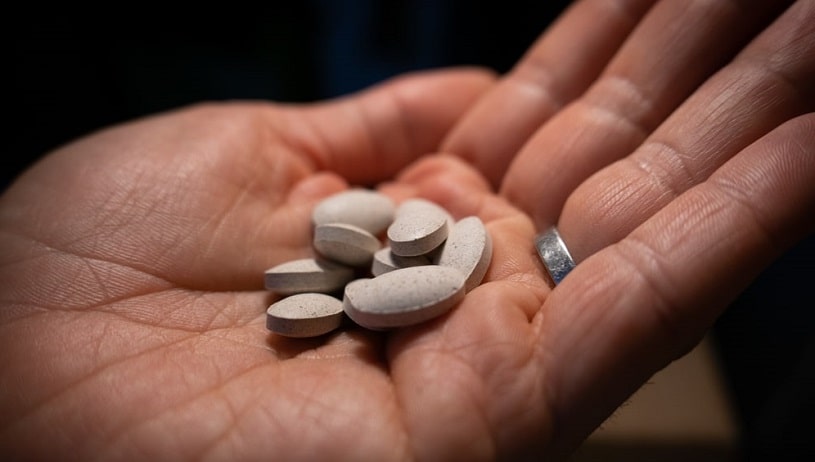Most people taking Catapres are unaware of how long it remains in their system. However, it’s something all users should know, as the Clonidine half-life can impact everything from having a drink with dinner to when it is safe to take other medications.
Table Of Contents:
Learn more about the Clonidine mechanism of action, how long it takes to work, and to be eliminated from the system.
Clonidine Mechanism Of Action
Catapres is a drug typically used in the treatment of hypertension. However, it is also used for other conditions, including treatment of withdrawal symptoms from other drugs. And although it treats withdrawal, upon cessation there is a great chance of Clonidine withdrawal, too.
How does Clonidine work? Cataptes is a centrally-acting adrenergic blocker that works through the activation of alpha-2 receptors. Alpha-2 receptors act as a part of the regulatory mechanism of the sympathetic nervous system, and their activation prevents the further release of catecholamines. This way, Clonidine MOA leads to a decrease in the activity of the sympathetic nervous system.

This reduced activation of the sympathetic nervous system leads to reduced release of norepinephrine, the primary sympathetic neurohormone of the body. It leads to the dilation of arterial blood vessels due to relaxation of the smooth muscle located within the walls of arterial blood vessels and a subsequent fall in arterial blood pressure. Clonidine mechanism of action proves the drug effective against hypertension.
How Long for Clonidine to Work?
There are immediate-release (IR) and extended-release (ER) formulations of this medicine. The peak plasma concentration after oral IR administration is reached in approximately 1 to 5 hours.
The second type (ER) is also not recommended to use for children under six years old. The peak concentrations were approximately 50% of those achieved with the IR formulation and occurred around 5 hours later. And total systemic bioavailability after the ER formulation was about 89% of that after the IR formulation.
How long for Clonidine to work to see the results? Typically, the drug is taken for two weeks before one can see the result of Clonidine MOA. Also, it can be prescribed for a more extended period, for example, 2-4 months, to see the benefits of Catapres use. Patients can see the maximum outcome after 4-8 weeks.
How Long Does Clonidine Last?
The drug is quickly absorbed, and the peak effects are seen within 1-3 hours. Clonidine MOA has the blood pressure-lowering effect that happens within 30-60 minutes after an oral dose, and the maximal effect on blood pressure occurs within 2-4 hours.
How Long Does Clonidine Stay In Your System?
Knowing Clonidine half-life and how long a dose remains in the system is vital for any user. Those taking the medication should be empowered in their knowledge, and sometimes, they will need to safely time taking other drugs with this one.
Catapres peak time is three to five hours after taking the oral dose; when injected or taken via a patch, peak time hits sooner. It is when the medication is at its most concentrated. Clonidine half-life is reached at roughly 14 hours for most patients. It can extend to 33 hours in pediatric patients.

However, those with poor renal function may not reach Catapres plasma half-life—when the plasma concentration is at half of that seen at its peak—for 41 hours. These individuals need to take extra care when starting medications or other drugs that can interact with Catapres. Clonidine’s total body clearance (CL) is 219±92 mL/min on average, though it tends to be slower in women than men.
It is important to note that the specifics on peak time, half-life, and total clearance can vary significantly between patients and even between routes of administration. As such, users worried about these aspects should consult with their doctor.
Factors That Impact How Long Clonidine Stays In The System
While there is plenty of data on Clonidine half-life and how long it stays in the system, patients need to remember that the numbers given are averages, and their ability to clear the drug will vary. Numerous factors impact the half-life of Catapres and its full clearance from the body.
These Include:
- The formula of the medication taken
- Dose used
- How often one took the medication
- Height and body mass of the user
- How hydrated the patient is
- The reason why it is taken (for example, someone taking Clonidine for sleep is less likely to have struggles metabolizing it than someone with circulation problems)
- If the user is physically active
- Metabolic rate
- Problems with kidney function
- Drug and alcohol use
- Gender
- Other accompanying medical conditions
Because there are many factors at play, patients should not take general half-life and full elimination timelines as hard and fast rules. Always work directly with a doctor when there are concerns about Catapres interactions.
Does Clonidine Show Up On A Drug Test?
Drug testing for this class of drugs is infrequent. However, some tests can detect it. Hypertension medications are not common drugs of abuse, even when they have abuse potential. Most of the time, they will only be tested if there is a specific reason. For example, if abuse of Catapres is suspected, a doctor might order a drug test. Otherwise, users should not anticipate being screened for it.
So, how long does Clonidine stay in your system for a drug test?
Urine Test
Assuming that someone is being tested for Catapres presence, they can expect their urine test to deliver a positive result if the medication has been taken in the last three days. Catapres has a total clearance of 177 mL/min and renal clearance of 102 mL/min. A urine drug test is the most common test for the medication.
Blood, Saliva, and Hair Tests
Clonidine drug test does not usually include blood, saliva, or hair screening. However, it is still possible in some instances. It would typically occur if there is a specific reason for testing, and presence needs to be verified outside of the urine testing window. Patients should confirm the details of testing with the lab in advance.
False Positives
Patients might worry about getting a false positive on a drug screening with any medication, especially if they must take them for employment. Catapres false positives are so rare as to be statistically insignificant. While other ADHD medications do cause false positives at a semi-high rate, because Catapres is not designed for ADHD treatment, it acts differently on the body.

There is more significant concern regarding false results in medical testing for types of cancers, specifically, pheochromocytoma and paragangliomas that secrete epinephrine, norepinephrine, or both. That is because Catapres can lower these chemicals in the body by as much as 50 percent. While the medication should be suppressed in advance of sample collection, this is not always done. Additionally, certain medications can prevent suppression, including β-adrenergic blockers, tricyclic antidepressants, and thiazide diuretics. For those who need frequent testing for epinephrine or norepinephrine presence, it might be best to consider alternatives.
Recovering From Misuse
The Clonidine mechanism of action shows that the drug effectively treats hypertension, and patients can benefit from it. However, it’s crucial to know about the medication’s half-life to avoid Clonidine overdose or dangerous interactions.
Although the medication is generally safe, not everyone who takes it does so by following their doctor’s orders. Some abuse the medication. For those looking to stop use and live a sober life, drug rehab facilities are the place to start. These centers offer a wide range of substance abuse treatment options to meet the needs of every patient.
Hope Without Commitment
Find the best treatment options. Call our free and confidential helpline
Most private insurances accepted
Page Sources
- Catapres® (clonidine hydrochloride, USP). Boehringer Ingelheim International. 2009. https://www.accessdata.fda.gov/drugsatfda_docs/label/2009/017407s034lbl.pdf.
- Basker S, Singh G, Jacob R. Clonidine in paediatrics - a review. Indian Journal of Anaesthesia. 2009; 53(3): 270–280. https://www.ncbi.nlm.nih.gov/pmc/articles/PMC2900117/.
- Sullivan PA, De Quattro V, Foti A, Curzon G. Effects of clonidine on central and peripheral nerve tone in primary hypertension. Hypertension. 1986; 8(7): 611-7. https://www.ncbi.nlm.nih.gov/pubmed/3721561.
- Isaac, L. (1980). Clonidine in the central nervous system: site and mechanism of hypotensive action. Journal of cardiovascular pharmacology, 2, S5-19. https://pubmed.ncbi.nlm.nih.gov/6154837/.
- Dollery, C. T., Davies, D. S., Draffan, G. H., Dargie, H. J., Dean, C. R., Reid, J. L., ... & Murray, S. (1976). Clinical pharmacology and pharmacokinetics of clonidine. Clinical Pharmacology & Therapeutics, 19(1), 11-17. https://pubmed.ncbi.nlm.nih.gov/1245090/.

 Authored by
Authored by  Reviewed by
Reviewed by 
